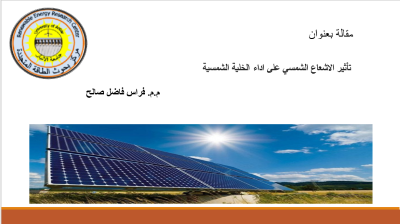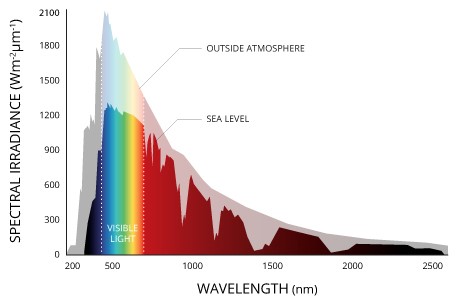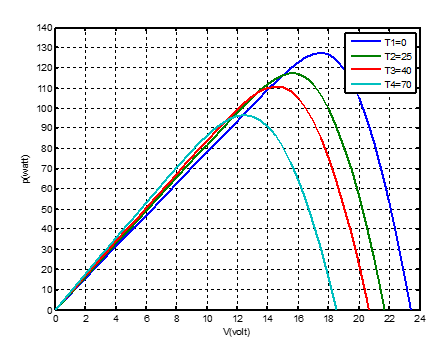| News Details |
The effect of solar radiation on the performance of the solar cell
2022-06-28

Firas Fadhil Salih
Most of us would assume that stronger and hotter the sun is, the more electricity our solar panels will produce. But that’s not the case. One of the key factors affecting the amount of power we get from a solar system is the temperature. Although the temperature doesn’t affect the amount of sunlight a solar cell receives, it does affect how much power is produced.
Solar cells are made of semiconductor materials, like the most used crystalline silicon. Semiconductors are sensitive to temperature changes. Temperatures above the optimum levels decrease the open circuit voltage of solar cells and their power output, while colder temperatures increase the voltage of solar cells.
The output of most solar panels is measured under Standard Test Conditions (STC) – this means a temperature of 25 degrees Celsius. The test temperature represents the average temperature during the solar peak hours of the spring and autumn.
According to the manufacture standards, 25 °C temperature indicates the peak of the optimum temperature range of photovoltaic solar panels. It is when solar photovoltaic cells are able to absorb sunlight with maximum efficiency and when we can expect them to perform the best.
The solar panel output fluctuates in real life conditions. It is because the intensity of sunlight and temperature of solar panels changes throughout the day. What interests us in this case is how does the temperature affect solar panel efficiency in real life. Let’s break it down.
Solar radiation is radiant (electromagnetic) energy from the sun. It provides light and heat for the Earth and energy for photosynthesis. This radiant energy is necessary for the metabolism of the environment and its inhabitants. The three relevant bands, or ranges, along the solar radiation spectrum, are ultraviolet, visible (PAR), and infrared. Of the light that reaches Earth’s surface, infrared radiation makes up 49.4% while visible light provides 42.3%. Ultraviolet radiation makes up just over 8% of the total solar radiation. Each of these bands has a different impact on the environment.

Spectral irradiance of solar sun
The amount and intensity of solar radiation that a location or body of water receives depend on a variety of factors. These factors include latitude, season, time of day, cloud cover and altitude. Not all radiation emitted from the sun reaches Earth’s surface. Much of it is absorbed, reflected or scattered in the atmosphere. At the surface, solar energy can be absorbed directly from the sun, called direct radiation, or from light that has been scattered as it enters the atmosphere, called indirect radiation.
Solar radiation with wavelengths of 380 nm to 750 nm (violet to red) strikes the material with enough energy to knock electrons from their weak bonds and create an electric current. The unused wavelengths (ultraviolet & infrared) do not have enough energy to dislodge the electrons and are absorbed as heat. The shorter the wavelength of incident light, the higher the frequency of the light and the more energy possessed by ejected electrons. In the same way, photovoltaic cells are sensitive to wavelength and respond better to sunlight in some parts of the spectrum than others.
A PV module’s temperature has a great effect on its performance. It is very important to observe that at high temperatures, a PV module’s power output is reduced. The temperature of a PV module also affects its efficiency. In general, a crystalline silicon PV module’s efficiency will be reduced by about 0.3-0.5 per cent for every degree °C increase in temperature. The effect of varying temperature does not have a very large effect on the current development. But we see a voltage drop with increasing heat.
The dominant effect with increasing cell’s temperature is the linear decrease of the open-circuit voltage, the cell being thus less efficient. The short circuit current slightly increases with the cell temperature increasing at constant irradiance, the voltage output from PV array decreases but current output increases slightly with respect to voltage and, hence the power output from PV array decreases.
The influence of the cell temperature on the I-V characteristics is illustrated in figure (1). The figure shows the effect of temperature variation (0°C, 25°C, 40°C, and 70°C) on the I-V characteristics for constant irradiance of G=1sun, and diode ideality factor of n=1.2. From figure (2) we can observe that when the temperature increases, the output power for both models decreases.
.jpg)
Fig. 1: I–V characteristic curve with temperature variation

Fig. 2: P–V characteristic curve with temperature variation
References
1. Wetzel, R. G. (2001). Limnology: Lake and River Ecosystems (3rd ed.). San Diego, CA: Academic Press.
2. https://greentumble.com/effect-of-temperature-on-solar-panel-efficiency/









